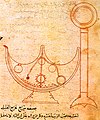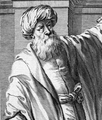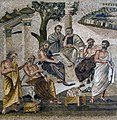Portal:History of science
The History of Science Portal
The history of science covers the development of science from ancient times to the present. It encompasses all three major branches of science: natural, social, and formal. Protoscience, early sciences, and natural philosophies such as alchemy and astrology during the Bronze Age, Iron Age, classical antiquity, and the Middle Ages declined during the early modern period after the establishment of formal disciplines of science in the Age of Enlightenment.
Science's earliest roots can be traced to Ancient Egypt and Mesopotamia around 3000 to 1200 BCE. These civilizations' contributions to mathematics, astronomy, and medicine influenced later Greek natural philosophy of classical antiquity, wherein formal attempts were made to provide explanations of events in the physical world based on natural causes. After the fall of the Western Roman Empire, knowledge of Greek conceptions of the world deteriorated in Latin-speaking Western Europe during the early centuries (400 to 1000 CE) of the Middle Ages, but continued to thrive in the Greek-speaking Byzantine Empire. Aided by translations of Greek texts, the Hellenistic worldview was preserved and absorbed into the Arabic-speaking Muslim world during the Islamic Golden Age. The recovery and assimilation of Greek works and Islamic inquiries into Western Europe from the 10th to 13th century revived the learning of natural philosophy in the West. Traditions of early science were also developed in ancient India and separately in ancient China, the Chinese model having influenced Vietnam, Korea and Japan before Western exploration. Among the Pre-Columbian peoples of Mesoamerica, the Zapotec civilization established their first known traditions of astronomy and mathematics for producing calendars, followed by other civilizations such as the Maya.
Natural philosophy was transformed during the Scientific Revolution in 16th- to 17th-century Europe, as new ideas and discoveries departed from previous Greek conceptions and traditions. The New Science that emerged was more mechanistic in its worldview, more integrated with mathematics, and more reliable and open as its knowledge was based on a newly defined scientific method. More "revolutions" in subsequent centuries soon followed. The chemical revolution of the 18th century, for instance, introduced new quantitative methods and measurements for chemistry. In the 19th century, new perspectives regarding the conservation of energy, age of Earth, and evolution came into focus. And in the 20th century, new discoveries in genetics and physics laid the foundations for new sub disciplines such as molecular biology and particle physics. Moreover, industrial and military concerns as well as the increasing complexity of new research endeavors ushered in the era of "big science," particularly after World War II. (Full article...)
Selected article -

The classical elements typically refer to earth, water, air, fire, and (later) aether which were proposed to explain the nature and complexity of all matter in terms of simpler substances. Ancient cultures in Greece, Angola, Tibet, India, and Mali had similar lists which sometimes referred, in local languages, to "air" as "wind", and to "aether" as "space".
These different cultures and even individual philosophers had widely varying explanations concerning their attributes and how they related to observable phenomena as well as cosmology. Sometimes these theories overlapped with mythology and were personified in deities. Some of these interpretations included atomism (the idea of very small, indivisible portions of matter), but other interpretations considered the elements to be divisible into infinitely small pieces without changing their nature. (Full article...)
Selected image

ENIAC, short for Electronic Numerical Integrator and Computer, was the first large-scale, electronic, digital computer capable of being reprogrammed to solve a full range of computing problems, although earlier computers had been built with some of these properties. ENIAC was designed and built to calculate artillery firing tables for the U.S. Army's Ballistics Research Laboratory. The first problems run on the ENIAC however, were related to the design of the hydrogen bomb.
This photo has been artificially darkened, obscuring details such as the women who were present and the IBM equipment in use. The original photo can be seen in the article: Rose, Allen (April 1946). "Lightning Strikes Mathematics". Popular Science: 83–86. Retrieved 15 April 2012.
Did you know
...that in the history of paleontology, very few naturalists before the 17th century recognized fossils as the remains of living organisms?
...that on January 17, 2007, the Doomsday Clock of the Bulletin of the Atomic Scientists moved to "5 minutes from midnight" in part because of global climate change?
...that in 1835, Caroline Herschel and Mary Fairfax Somerville became the first women scientists to be elected to the Royal Astronomical Society?
Selected Biography -
Robert Hooke FRS (/hʊk/; 18 July 1635 – 3 March 1703) was an English polymath who was active as a physicist ("natural philosopher"), astronomer, geologist, meteorologist and architect. He is credited as one of the first scientists to investigate living things at microscopic scale in 1665, using a compound microscope that he designed. Hooke was an impoverished scientific inquirer in young adulthood who went on to become one of the most important scientists of his time. After the Great Fire of London in 1666, Hooke (as a surveyor and architect) attained wealth and esteem by performing more than half of the property line surveys and assisting with the city's rapid reconstruction. Often vilified by writers in the centuries after his death, his reputation was restored at the end of the twentieth century and he has been called "England's Leonardo [da Vinci]".
Hooke was a Fellow of the Royal Society and from 1662, he was its first Curator of Experiments. From 1665 to 1703, he was also Professor of Geometry at Gresham College. Hooke began his scientific career as an assistant to the physical scientist Robert Boyle. Hooke built the vacuum pumps that were used in Boyle's experiments on gas law and also conducted experiments. In 1664, Hooke identified the rotations of Mars and Jupiter. Hooke's 1665 book Micrographia, in which he coined the term cell, encouraged microscopic investigations. Investigating optics – specifically light refraction – Hooke inferred a wave theory of light. His is the first-recorded hypothesis of the cause of the expansion of matter by heat, of air's composition by small particles in constant motion that thus generate its pressure, and of heat as energy. (Full article...)
Selected anniversaries
- 1748 - Death of Johann Bernoulli, Swiss mathematician (b. 1667)
- 1774 - Birth of André Marie Constant Duméril, French zoologist (d. 1860)
- 1796 - Death of Alexandre-Théophile Vandermonde, French mathematician (b. 1735)
- 1800 - Death of Louis-Jean-Marie Daubenton, French naturalist (b. 1716)
- 1801 - The dwarf planet Ceres is discovered by Giuseppe Piazzi
- 1803 - Birth of Guglielmo Libri Carucci dalla Sommaja, Italian mathematician (d. 1869)
- 1817 - Death of Martin Heinrich Klaproth, German chemist (b. 1743)
- 1852 - Birth of Eugène-Anatole Demarçay, French chemist (d. 1904)
- 1853 - Death of Gregory Blaxland, Australian explorer (b. 1778)
- 1854 - Birth of Sir James George Frazer, Scottish anthropologist (d. 1941)
- 1862 - Death of Mikhail Vasilievich Ostrogradsky, Russian physicist (b. 1801)
- 1876 - Birth of Harriet Brooks, Canadian physicist (d. 1933)
- 1878 - Birth of Agner Krarup Erlang, Danish scientist and engineer (d. 1929)
- 1890 - Birth of Anton Melik, Slovenian geographer (d. 1966)
- 1894 - Birth of Satyendra Nath Bose, Indian mathematician (d. 1974)
- 1894 - Death of Heinrich Rudolf Hertz, German physicist (b. 1857)
- 1905 - Birth of Stanisław Mazur, Polish mathematician (d. 1981)
- 1912 - Birth of Boris Vladimirovich Gnedenko, Russian mathematician (d. 1995)
- 1917 - Birth of Jule Gregory Charney, American meteorologist (d. 1981)
- 1925 - The American astronomer Edwin Hubble announces the discovery of galaxies outside the Milky Way
- 1931 - Death of Martinus Beijerinck, Dutch microbiologist and botanist (b. 1851)
- 1943 - Birth of Raghunath Anant Mashelkar, Indian scientist
- 1995 - Death of Eugene Wigner, Hungarian physicist, Nobel laureate (b. 1902)
- 2007 - Death of Leon Davidson, American scientist known for studying UFOs (b. 1922)
- 2007 - Death of Roland Levinsky, South African medical scientist (b. 1943)
Related portals
Topics
General images
Subcategories
Things you can do
Help out by participating in the History of Science Wikiproject (which also coordinates the histories of medicine, technology and philosophy of science) or join the discussion.
Associated Wikimedia
The following Wikimedia Foundation sister projects provide more on this subject:
-
Commons
Free media repository -
Wikibooks
Free textbooks and manuals -
Wikidata
Free knowledge base -
Wikinews
Free-content news -
Wikiquote
Collection of quotations -
Wikisource
Free-content library -
Wikiversity
Free learning tools -
Wiktionary
Dictionary and thesaurus









































































